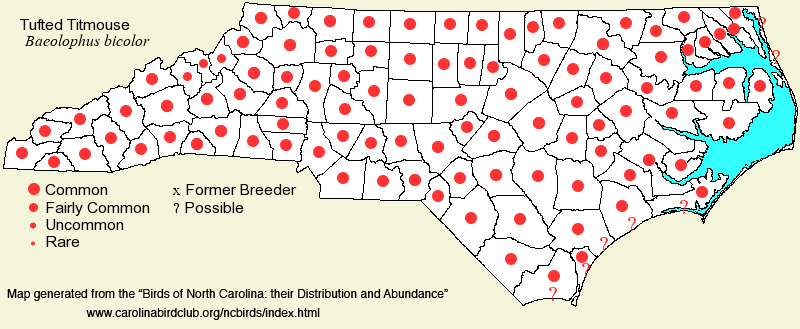 |  |
|
Tufted Titmouse - Baeolophus bicolor PARIDAE Members: | Search Common: Search Scientific: |
|
|
|||||||
| General Comments | The Tufted Titmouse is the Carolina Chickadee's close cousin, even though chickadees and titmice were split into different genera in the late 1990's; previously, both groups were in the genus Parus. Like that species, it occurs across the Eastern half of the country, is essentially non-migratory, and nests in all 100 North Carolina counties. Unlike the chickadee, it tends to be scarce toward the immediate coast, and is scarce or absent in some forested areas on islands. In recent years, it seems to have "colonized" Bogue Banks, where the chickadee has long been a breeder. It is often the first bird to investigate a new bird feeder, and it is a nucleus species, along with the Carolina Chickadee, in winter flocks of birds that move through pine and mixed forests. It prefers somewhat more hardwood-based forests than does the chickadee, and tends to be scarce in pine stands except in winter. But, they can be found in most hardwood or mixed forests, often in residential areas, across the state. | ||||||
| Breeding Status | Breeder | ||||||
| NC BRC List | Definitive | ||||||
| State Status | |||||||
| U.S. Status | |||||||
| State Rank | S5 | ||||||
| Global Rank | G5 | ||||||
| Coastal Plain | Permanent resident; non-migratory. Common to very common resident across the province, though mostly uncommon to fairly common within a few miles of salt or brackish water. Absent from Buxton Woods and Bodie Island, not common on Bogue Banks, and not common in some refuges and parks on the Pamlimarle Peninsula. Peak counts: | ||||||
| Piedmont | Permanent resident; non-migratory. Common to very common across the province. Peak counts: 357, Jordan Lake spring count, 7 May 2000. | ||||||
| Mountains | Permanent resident; non-migratory. Common up to about 4,500 feet, and ranges sparingly up to about 5,500 feet, very rarely higher. In winter, moves downward from the higher elevations. Peak counts: | ||||||
| Finding Tips |
None needed. **** | ||||||
| Attribution | LeGrand[2023-03-26], LeGrand[2012-09-16], LeGrand[2011-12-11] | ||||||
| NC Map Map depicts all counties with a report (transient or resident) for the species. | Click on county for list of all known species. |
| NC Breeding Season Map Map depicts assumed breeding season abundance for the species. |  |